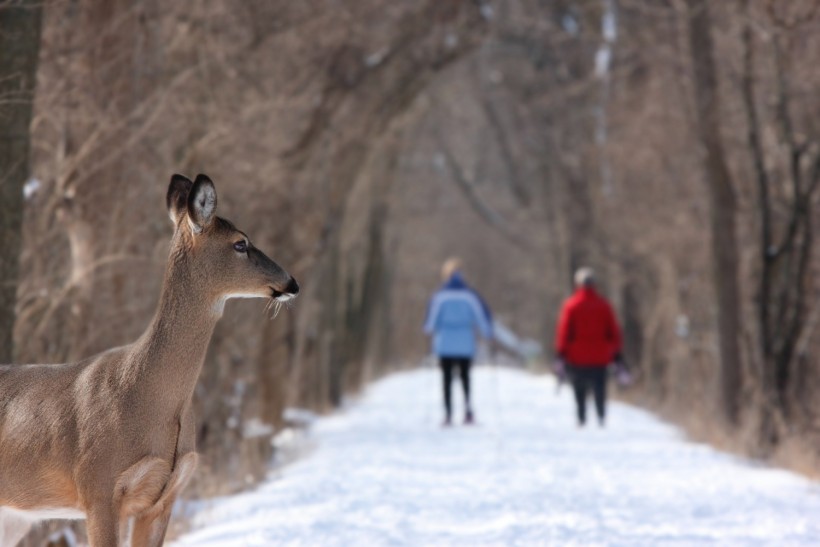
The evolution of the COVID-19 virus in white-tailed deer is three times faster, prompting fears for interspecies transmission.
Since the COVID-19 virus can evolve three times more quickly in white-tailed deer than it does in humans, scientists are concerned about the prospect of interspecies transmission.
COVID-19 in White-Tailed Deer, 30 Spillovers From Humans
Ohio State University (OSU) researchers found that white-tailed deer carry the COVID-19 virus, evolving three times faster than humans. From November 2021 to March 2022, they tested 1,522 deer in 83 of Ohio's 88 counties, revealing over 10% positive samples, where 59% of the tested counties were affected. Genomic analysis showed 30 deer infections from humans.
Prof. Andrew Bowman, one of the researchers from OSU, stated rare interspecies transmission is evident; 30 spillovers were documented, suggesting easy transmission between humans and animals. Growing evidence shows a two-way transmission is a possibility, where humans can contract it from deer. The study highlights virus dynamics in wildlife and potential cross-species infection, which is raising concerns among experts.
White-tailed deer serve as a COVID-19 virus reservoir, fostering mutations and potential transmission to other animals. In December 2021, researchers found the virus in Ohio deer at 9 sites. The team later expanded monitoring across various areas and revealed widespread presence, where urban and rural deer both tested positive. Antibodies were found in numerous blood samples, indicating that about 23.5% of Ohio's white-tailed deer likely contracted the virus. This highlights the deer's role in virus dynamics and suggests potential risks of transmission to wildlife and livestock.
Evidence for Multiple Spillovers
In 80 whole-genome sequences from samples, researchers found that 90% of the deer contracted the delta variant, which was dominant in fall 2021 in the US, along with the alpha variant. The deer's delta cases closely matched human variants at the same time, indicating multiple spillovers. Deer-to-deer transmission occurred in clusters crossing counties.
The timing suggests that some deer hold extinct human lineages of the alpha variant, while the human delta variant peaks. This prompted researcher Bowman to raise concerns about deer preserving outdated human variants.
If the virus spreads to humans again, immunization via vaccination is most recommended by experts to shield people against deadly infections. For instance, research on the impact of virus variants from deer on Siberian hamsters-an animal model frequently used in COVID-19 studies-showed unmistakably that vaccinated hamsters did not become sick as quickly as unvaccinated ones did after infection.
Also Read: Zombie Deer with Chronic Wasting Disease Seen Acting Abnormally in Oklahoma
Could Faster Evolution of the Virus in Deer Spill Back to Humans?
Unfortunately, it is anticipated that the deer variations in circulation will continue to evolve more quickly than those seen in humans.
According to Bowman, deer are not only acquiring and sustaining the COVID-19 virus, also known as SARS-CoV-2, but their pace of evolution is also accelerating, maybe in a different direction than that of people.
Additional investigation is required to determine how the virus spreads from humans to white-tailed deer and to determine whether altered forms are likely to return to humans.
Although significant deer-origin strain outbreaks have not yet affected humans, animal-to-animal transmission is still quite likely. Additionally, since around 70% of Ohio's deer that are allowed to roam freely have not yet been exposed to the virus, there are a lot of immunologically immature animals that the virus might spread unchecked.
Bowman concludes that the presence of the animal host puts dangers into play. Bowman raises the question of whether this could become a route into other animal hosts, whether wild or domestic if this trajectory persists for years and a virus evolves to become deer-adapted.
Related Article: Fatal Chronic Wasting Disease Halts Rehabilitation Efforts for White-Tailed Deer Fawns in Tennessee
© 2024 NatureWorldNews.com All rights reserved. Do not reproduce without permission.



![Roundworms with Short Memories 'Stop Forgetting' When Frozen or Given Lithium [Study]](https://1471793142.rsc.cdn77.org/data/thumbs/full/70295/280/157/50/40/roundworms-with-short-memories-stop-forgetting-when-frozen-or-given-lithium-study.jpg)

